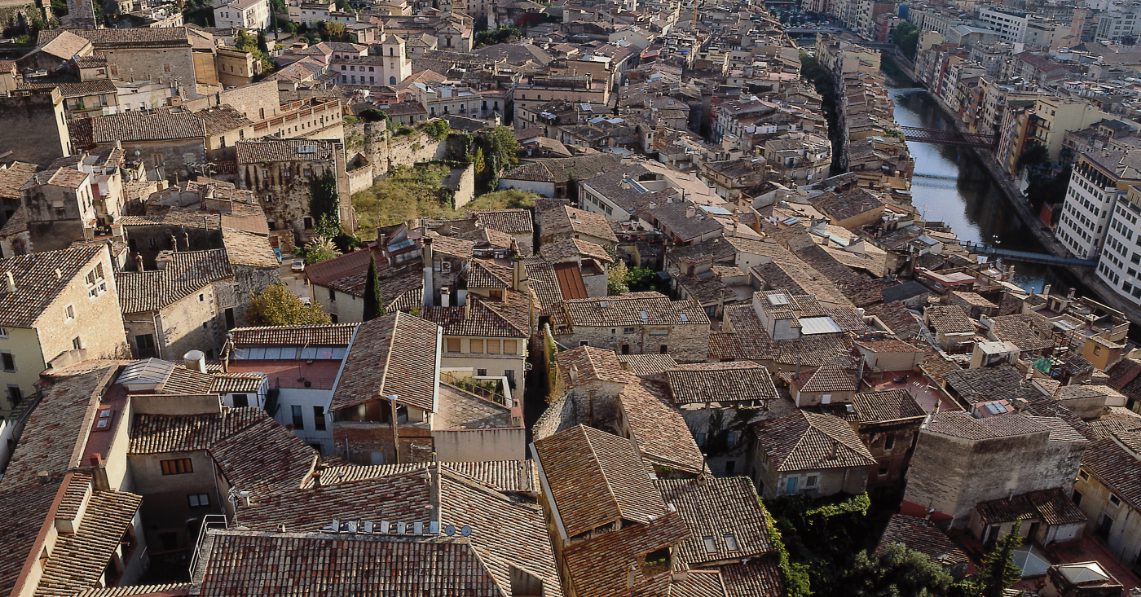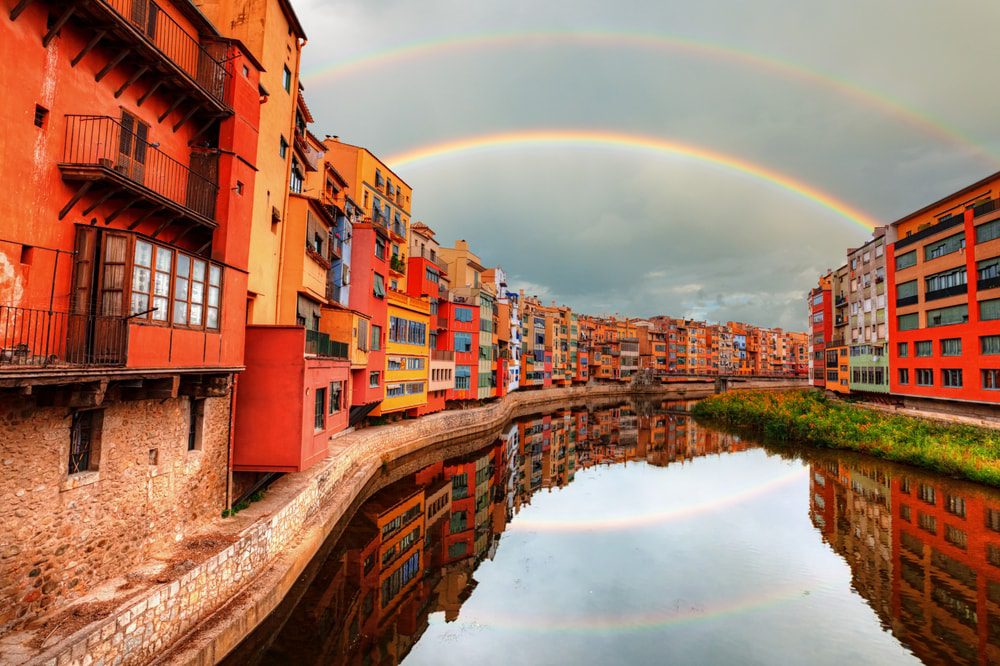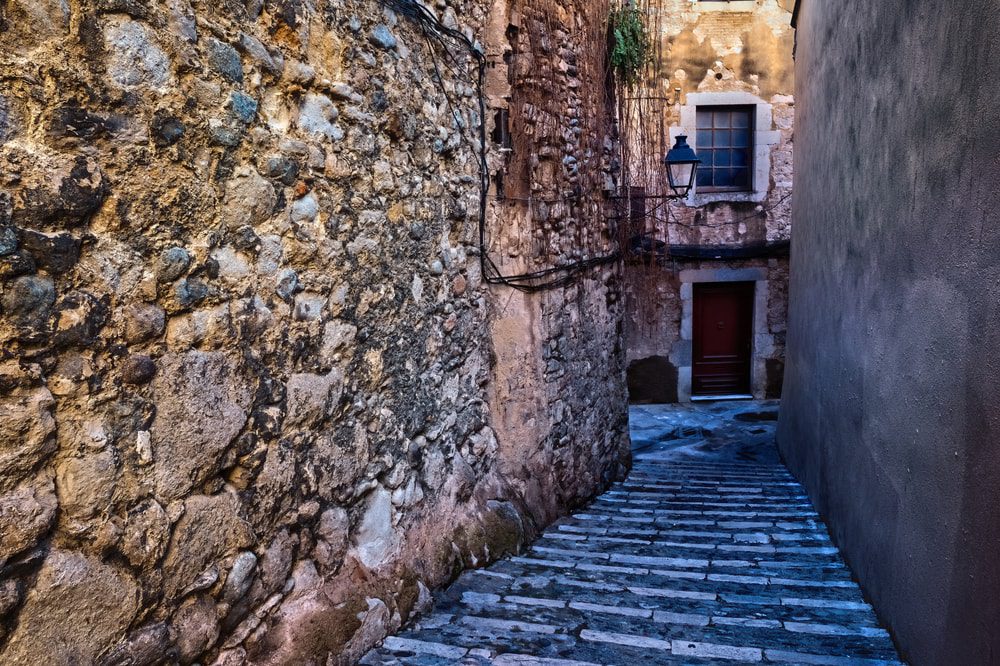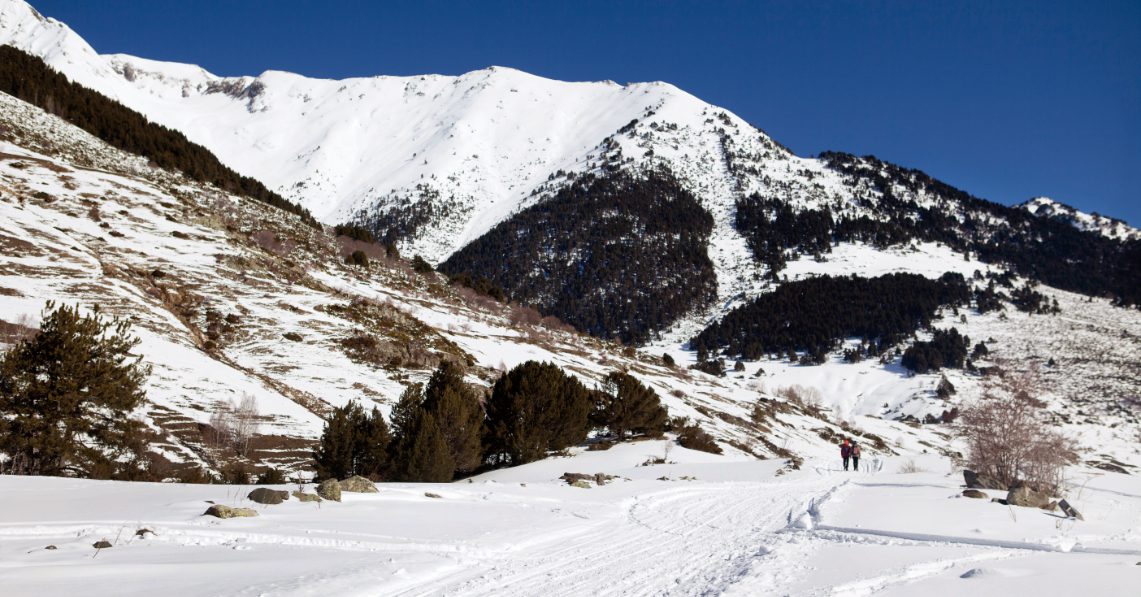The Catalan Route – Girona
Girona introduction
Girona is in the north of Catalonia, 99 km northeast of Barcelona, and 30 km south of the French border. The first documentary record of a Jewish presence dates from year 890, when some twenty Jewish families arrived in the city and settled near the Christian cathedral. A document dated to the year 1160 features the word “Call”, which implies the existence of a physical Jewish Quarter and a well-organized community. The Jewish community enjoyed its moment of splendour in the 13th century, with a renowned school of Kabbalah and illustrious figures such as Nachmanides. Within the framework of the economic and social crisis of the 14th century, the situation became increasingly difficult for the community, marked by episodes of persecution and violence that ended in 1492, with the Decree of Expulsion.
Today, the historic medieval Jewish Quarter, or “Call”, has been recovered with the opening in the year 2000 of the Museum of Jewish History. Both the “Call” and the Museum are highlights in the Old City, a must for both locals and foreign visitors.
Learn more about us and check our:
Girona in detail
The city of Girona is just north of Barcelona and 60 kilometres south of the French border and hosts an incredible history and a fascinating Jewish story. Caught between the Pyrenees and the Costa Brava, surrounded by fertile countryside, undulating mountains, Girona is unique for its preservation of Medieval old city. Today, Girona has become a centre of research and a leader in the investigation into the history of the Catalan Jews. Its Jewish quarter is famed as one of the best preserved in Europe, its streets and winding passages, remains of Jewish houses, making it a spectacular place to visit and discover this history.
When we think of the story of the Jews in Spain, our mind may wander to the south, the Golden Age in the 9th and 10th centuries, the great Glory of Cordoba, the orange lined streets of Seville, centuries of scientific, mathematic and religious exchange and exploration, shared and co-lived among the intellectual elite of Arab, Christians and Jews.
However, we lived a slightly different story in this corner of the Iberian Peninsula. Occupied by the Arabs for less than a century, the so called ‘golden age’ of the Jews in this territory would reach its climax in size and cultural grandeur in the 12th and 13th centuries. Girona would become an important rabbinical centre, an important centre of Kabbalah, birthplace of famous Rabbi, Nahmanides, by walking through its history we shine light on another piece of the puzzle of the history of the Jews in Catalunya.
According to documents, the first Jewish families which established in Girona in 890. They had to move to the city after the lord of Girona, Dela, had sold the lands they were leaving – those were to the north-west of Girona, not far from Besalú, another charming medieval town – and since lord Dela had been providing them some houses there, close to his palace. As most of the cities in the Early Middle Ages, we might imagine Girona not as a sprawling metropolis but as a small, rural city, so it makes sense that lord Dela was trying to push Girona’s activity with these kinds of policies.
In the 9th century Girona didn’t look much like the monumental one we see nowadays. At that time the cathedral was a smaller, a pre-Romanesque building, while the square that now stands in front of it was full of houses and narrow streets, remaining structures of the Roman city. This was the area where the first 25 Jewish families settled and created the first synagogue.
Throughout the 11th century most of them moved to the spot of the ancient Via Augusta, while at the same time the community was growing and forming a population group large enough to be recognized as an Aljama.
The word Aljama refers to Jewish Communities with their own governing council and religious institutions, synagogues and Jewish schools, a rabbinic tribunal, hospital services, and ritual services, such as a Mikveh, funeral service, kosher butcher and slaughterhouse. There were over 30 official Aljamas in Catalunya- main ones being Barcelona, Perpignan, Girona, Lleida and Tortosa. However, it is documented that there were more than 150 Jewish communities of varying capacities- rural communities, some with basic Jewish services, others isolated groups of families, which would rely on the services of the main Aljamas to fulfil a Jewish life. Girona was an important centre for a large rural area.
The name for Jewish quarter in Catalonia is Call, and in fact, in many villages across Catalunya, we can see the remains of a forgotten history marked by street names, such as Carrer del Call. A Call in Catalunya, although closed and often with limited gated entrances, wasn’t a ghetto so to speak, but rather a designated area in which Jews lived together. It was a matter of convenience for both parties, as the King could keep a watchful eye on “his” Jews, overseeing any laws that he may have implemented, but also giving protection and allowing Jews to live a Jewish life, according to Jewish law. Head rabbis and leaders from the community had to negotiate with the King for permission on many issues, from the right to sell kosher meat to Christians neighbours, to the right to build or repair a synagogue. There was an internal governing body which would oversee issues within the community, legal or moral. And there was a complicated network amongst the Jewish communities, trade and religious exchange, linking north and south, East and west, even spreading into the Mediterranean via trade routes. As Catalan Jews, they spoke Catalan, studied in Hebrew and Latin, and knew Arabic language and customs, important not only as translators but also useful to the Crown on military and diplomatic campaigns.
One of the most notable members of this medieval community was the Ravaya family, who were one of the most important families in Girona, as some of its members served King Peter the Great as battles – administrating Girona in his name – or even as royal treasurer. Thanks to their intercession with the King allowed the Aljama of Girona and all the Aljamas that were part of the royal dominions to obtain very substantial privileges and concessions, some organizational improvements and an enhanced capacity to follow a lifestyle in accordance with the dictates of their religion. After 1284, Jews would be prohibited from holding public office, so Astruc and Jucef Ravaya, father and son, would be the last Jewish battles of Girona.
Between the eleventh and fifteenth centuries, more than one hundred and twenty Jewish authors devoted themselves to the study of philosophy, theology, exegesis, literature, astronomy, astrology and medicine. Likewise, the art of writing and expressing feelings translated into high quality, touching poems, was really prolific, by such figures as Merecina of Girona, Messulam de Piera, Moshe ben Nahman, Isaac ben Seshet, Mimó Gallipapa or Moshe Natan.

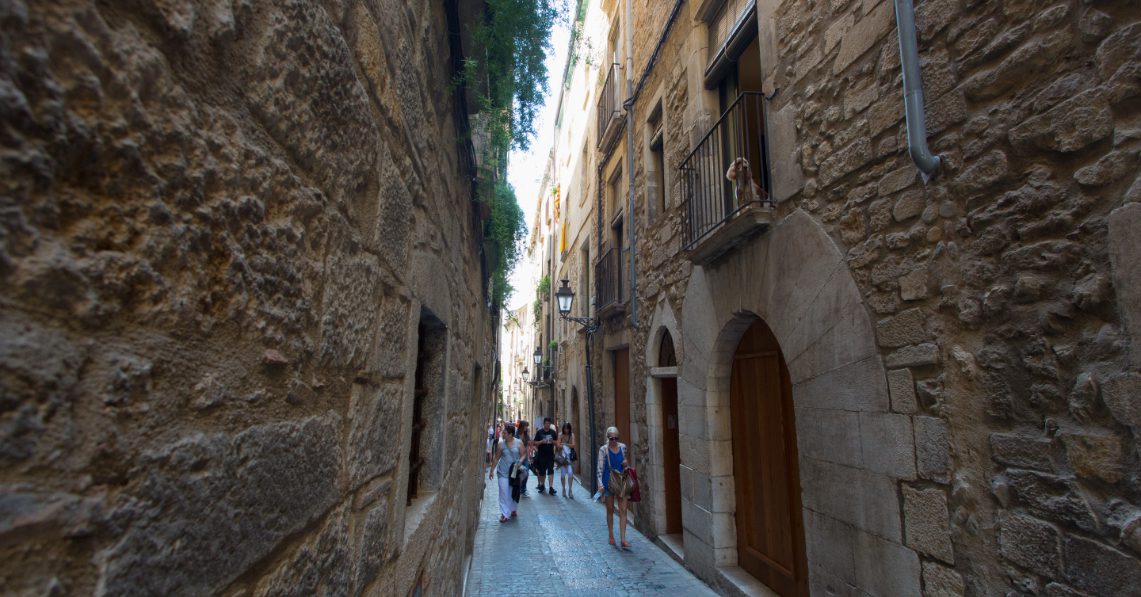
This activity was so important that in the 13th century Girona was known as City Mother of Israel by many European communities. Some examples are the translation of literature into several languages or the gothic Haggadot which survived till nowadays, many of them richly decorated. or the response, letters sent by rabbis as Nissim ben Rovèn Gerondi, to hundreds of communities who sought the advice of expert rabbis in all sorts of matters.
From the 13th century onwards, Kabbalistic literature underwent a great development thanks to a prolific production of texts, especially in the Languedoc, and Catalonia, where Girona played an important role. The ideas of the first Kabbalists of Provence were first spread to Catalonia. Kabbalist circles were founded in Barcelona, and another particularly important one was founded here in Girona, exploring this mysterious and complex esoteric Judaism. We can highlight two extraordinary figures: Azriel de Girona and his disciple, Moshe Ben Nahman, Nahmanides himself.
Azriel de Girona, also known as “the saint” is one of the founding masters of the Kabbalah in the city of Girona. Founder of the speculative cabala, at a young age, he was attracted to the mystical studies that began to spread through Catalonia and Provence, where he studied and was a disciple of Isaac the Blind, his teacher, in Narbonne.
Upon returning to Girona, Azriel founded a cabalistic school. He was the author of a commentary on the Song of Songs, where the 613 commandments are explained mystically, as well as a commentary to the Sefer Yetzirah. His system was fundamentally based on the Neo-Platonist conception of God as the endless (ein sof), the infinite. He would be the master to the great Nahmanides.
Nahmanides, in his Catalan name, Bonastruc ça Porta, also known with the acronym RaMbaN, Rabbi Moshe ben Nahman. In the words of Gershom Sholem, the greatest Talmudic authority of his generation in Hispanic lands. His work and legacy place him as a key figure in the history of the Jewish people. Some fifty books of Nahmanides have been preserved. In them, he gives us his vision of the destiny of the soul after death and brings us closer to the doctrine of transmigration of souls and nature of the coming world, common ideas in his circle that were opposite to Maimonides’ rationalistic and Aristotelian vision.
Interestingly, at a time when those two worlds were clashing, Nahmanides looked for a solution to that controversy, proposing a detailed program where he regulated the study of sciences according to the age of students and their place of birth.
He was the chief rabbi of Catalonia and acted as a great defender of Judaism, according to the memory he left in the Jewish aljamas of the West, in the famous disputation of Barcelona, called by the king James the Conqueror. After the great disputation of 1263, Nahmanides headed to the land of Israel, where he played an important role in Akko becoming the spiritual leader of the Jewish community, and in Jerusalem, where he founded a synagogue after the destruction of the city by the Mongol invaders.
The Jewish communities that lived in Christian territory were, always, minorities and quite often segregated. The idea of a supposed perfect life together of cultures is erroneous since what took place was more like coexistence between two communities: the Jewish and the Christian, who lived at the same time and physical space: the cities, towns and villages of medieval Catalonia.
For centuries, the coexistence of Jews and Christians was marked by the convenience of this relationship: commercial activity, medical services, and money lending, which were in large measure provided by the Jews were extremely important for the society and its development. At the same time, in every moment of crisis or conflict, minorities were the target of the society to whom they were focusing their frustrations.
First there were the accusations, which spread throughout all of Christian Europe. The Jews were accused of poisoning sources of drinking water or causing terrible epidemics like the Black Death, which battered Europe in 1348. This compounded an earlier common accusation of performing ritual sacrifices to harm Christianity such as using communion wafers.
The relationship between the Jewish population and its Christian surroundings became more and more difficult, and more and more often tainted with violence. In Girona, the violence had already begun at the end of the thirteenth century.
In 1331 an important attack took place that was stifled thanks to the intervention of the public authorities. But the great attack, the most violent one and that with the most terrible consequences, was on the of 10 August 1391. Groups of armed people entered the Call and caused 40 deaths. Because the Jews were supposed to be under Royal protection, they had been able to refuge here, in the Gironella Tower, where they were shut up under terrible conditions for more than 17 weeks. Many people decided to convert to Christianity in the face of the incessant threat and violence. Some other people decided to leave the city for never being back again.
Since most conversions were forced by fear and violence, were made without time or aptitude to learn the new religion, so many of them tried to keep and continue to practice the ancient Law of Moses in secret. These practices were the ones that the Inquisition persecuted for centuries, understanding them as heresy.
After the expulsion, in 1492, many of the Catalan Jewish families who had not converted yet moved to Italy, Provence, Algeria or the Ottoman Empire. In some cities, like Alger, Rome and Thessalonica, there were enough families to have their own synagogue and keep their practices following their nussakh, the liturgical ritual.
On the other hand, from 1492, and till 1966, Judaism was forbidden in all Spain, so the descendants of the converted Jewish families finally forgot their Jewish origin. Because of the persecution headed by the Inquisition and the weight of the years, the Jewish history of Girona and the whole Catalonia have been forgotten by most of the citizenship.
Despite this, after many centuries, the interest in the material remains of Jewish culture grew in the intellectual circles of Girona during the 19th and early 20th centuries, as can be seen in the works of some researchers, journalists, writers and even priests, who studied documentation and epigraphic remains of the Girona’s community. But it wasn’t until the recovery of democracy that the town council started a process of preservation, dissemination and enhancement of the Jewish heritage of Girona. With this proposal has been created the Patronat Call de Girona 1992, the public institution which manages the Museum of Jewish History of Girona. Through it the city has been promoting research, pedagogy and awareness towards this part of the history and culture of Girona and Catalonia.
And that’s not all, since more than 20 years, de Patronat Call de Girona is founder and a very active member of the European Association for the Preservation of Jewish Heritage, which is a network of ¿how many countries? working on research, preservation, dissemination and awareness of Jewish heritage all around Europe.
